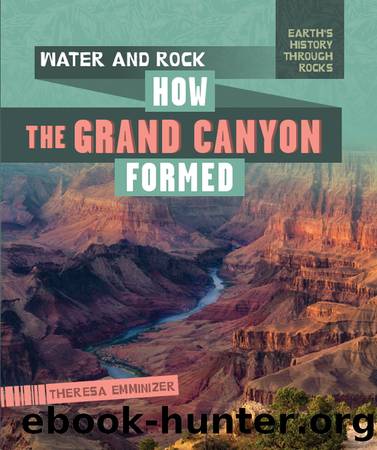Water and Rock: How the Grand Canyon Formed by Theresa Emminizer

Author:Theresa Emminizer [Emminizer, Theresa]
Language: eng
Format: epub
Publisher: The Rosen Publishing Group, Inc
SHIFTING UPWARD
The Kaibab Limestone is the topmost rock layer in the Grand Canyon. Based on radiometric dating, relative dating, and fossil identification, geologists have determined that this limestone likely was once an ocean floor. How exactly did the rock layer move from the ocean bottom to 9,000 feet (2,743.2 m) above sea level? The planet pushed it upward.
This geologic activity occurs in the lithosphere. This layer is made up of tectonic plates that float and move on top of a layer of soft rock. When the plates bump into each other, rocks on Earthâs surface shift.
Between 30 million and 70 million years ago, this activity changed the landscape of the Grand Canyonâs rock layers. The bumping plates pushed the rock layers upward, lifting the land and creating whatâs called the Colorado Plateau.
CONTINENTAL DRIFT
The continents that we know today were all once part of a supercontinent called Pangaea. Pangaea was a huge landmass that broke apart into pieces over time. The movement of tectonic plates caused the continents to shift. If you look closely at a map of Earth, you can imagine how the continents once fit together. Earthâs plates continue to move today, crashing into and pulling away from each other. This movement is where many kinds of geologic activity begin.
Download
This site does not store any files on its server. We only index and link to content provided by other sites. Please contact the content providers to delete copyright contents if any and email us, we'll remove relevant links or contents immediately.
| Earthquakes & Volcanoes | Environment |
| Flowers & Plants | Forests & Trees |
| Fossils | Gardening |
| Oceans & Seas | Rocks & Minerals |
| Water | Weather |
The Giant and How He Humbugged America by Jim Murphy(3379)
The Science Book (Big Ideas Simply Explained) by DK(3221)
Harry Potter: A History of Magic by British Library(2990)
The Elements by Theodore Gray(2982)
A Short History of Nearly Everything by Bryson Bill(2618)
Make by Mike Westerfield(2273)
Easy Electronics by Charles Platt(2272)
The Astronomy Book by DK(2100)
The Cat in the Hat by Dr. Seuss(2092)
CLICK'D by Tamara Ireland Stone(1838)
Science Experiments You Can Eat by Vicki Cobb(1820)
Calling All Minds by Temple Grandin(1776)
Think Like a Rocket Scientist by Ozan Varol(1768)
The Crime Book (Big Ideas Simply Explained) by DK(1747)
03 The Prophet of Yonwood by Jeanne DuPrau(1742)
Minecraft by Mojang Ab(1728)
Pax by Sara Pennypacker(1706)
Martin Gardner's Science Magic by Martin Gardner(1671)
Getting Started with Soldering: A Hands-On Guide to Making Electrical and Mechanical Connections by Vinck Marc de(1652)
